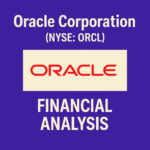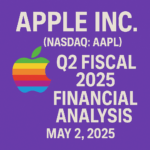Alphabet Inc. (NASDAQ: GOOG, GOOGL)
Q1 2025 Financial Analysis | April 24, 2025
Executive Summary
Alphabet Inc. (NASDAQ: GOOG, GOOGL) reported robust first-quarter 2025 results, demonstrating strong growth across its key business segments. The company's consolidated revenues increased 12% year-over-year (14% in constant currency) to $90.2 billion, driven by double-digit growth in Google Search & other, YouTube ads, Google subscriptions, platforms, and devices, and Google Cloud. Operating income rose significantly by 20% compared to the same period last year, with operating margin expanding by 2 percentage points to 34%. Net income surged 46% to $34.5 billion, with diluted EPS increasing 49% to $2.81. Reflecting its strong performance and commitment to shareholder returns, Alphabet announced a 5% increase to its quarterly dividend, resulting in a $0.21 per share quarterly cash dividend.
Q1 2025 Highlights
Financial Performance
Alphabet delivered strong financial performance in the first quarter of 2025, with consolidated revenues reaching $90.2 billion, representing a 12% increase year-over-year. When adjusted for the impact of foreign exchange, revenue growth was even stronger at 14% in constant currency. This robust revenue performance was driven by double-digit growth across key segments, including Google Search & other, YouTube ads, Google subscriptions, platforms, and devices, and Google Cloud.
Operating income for the quarter surged 20% to $30.6 billion, outpacing revenue growth and leading to a 2 percentage point expansion in operating margin to 34%. This margin improvement demonstrates Alphabet's ability to drive operational efficiencies while continuing to invest in growth areas like AI and cloud infrastructure.
Net income for Q1 2025 reached $34.5 billion, a substantial 46% increase compared to the same period last year. It's important to note that this figure includes an $8.0 billion unrealized gain on Alphabet's non-marketable equity securities related to an investment in a private company. Diluted earnings per share (EPS) grew 49% to $2.81, reflecting both the strong operational performance and the impact of the company's ongoing share repurchase program.
The company's financial position remains robust, with $95.3 billion in cash, cash equivalents, and marketable securities as of March 31, 2025. Free cash flow for the trailing twelve months ending Q1 2025 was $74.9 billion, showcasing Alphabet's significant cash generation capabilities despite increased capital expenditures to support growth initiatives.
Segment Performance
| Segment | Revenue ($B) | YoY Growth | Operating Income ($B) | YoY Growth | Operating Margin |
|---|---|---|---|---|---|
| Google Services | $77.3 | 10% | $32.7 | 17% | 42.3% |
| Google Cloud | $12.3 | 28% | $2.2 | 142% | 17.8% |
| Other Bets | $0.45 | -9% | -$1.2 | -20% | N/A |
| Hedging Gains | $0.26 | 261% | N/A | N/A | N/A |
| Alphabet-level Activities | N/A | N/A | -$3.0 | -31% | N/A |
| Total | $90.2 | 12% | $30.6 | 20% | 34% |
Google Services remains Alphabet's largest segment, generating $77.3 billion in revenue for Q1 2025, a 10% increase year-over-year. Within this segment, Google Search & other revenues grew by 10% to $50.7 billion, YouTube advertising revenues increased by 10% to $8.9 billion, while Google Network revenues declined slightly by 2% to $7.3 billion. Google subscriptions, platforms, and devices showed particularly strong growth of 19% to $10.4 billion, reflecting increasing consumer adoption of subscription services like YouTube TV, YouTube Music and Premium, NFL Sunday Ticket, and Google One. Operating income for the Google Services segment grew by 17% to $32.7 billion, resulting in an operating margin of 42.3%, an improvement from 39.6% in Q1 2024.
Google Cloud continued its impressive trajectory, with revenues increasing 28% year-over-year to $12.3 billion. This growth was led by Google Cloud Platform (GCP) across core products, AI Infrastructure, and Generative AI Solutions. The segment's profitability improved substantially, with operating income more than doubling to $2.2 billion from $900 million in Q1 2024. This resulted in an operating margin of 17.8%, a significant improvement from 9.4% in the prior year period, demonstrating the increasing scale and efficiency of Google's cloud operations.
Other Bets segment, which includes emerging businesses like Waymo and Verily, generated $450 million in revenue, a 9% decrease from the prior year. The operating loss for this segment increased to $1.2 billion from $1.0 billion in Q1 2024, reflecting continued investments in these longer-term initiatives.
Overall, the segment performance highlights Alphabet's strength across its core advertising business and expanding growth drivers in cloud computing and subscription services. The substantial improvement in Google Cloud's profitability is particularly noteworthy, as it indicates that the company's significant investments in this area are beginning to yield strong financial returns.
Revenue Breakdown & Trends
Google Services
Revenue Components
- Google Search & other: $50.7B (+10%)
- YouTube ads: $8.9B (+10%)
- Google Network: $7.3B (-2%)
- Google subscriptions, platforms, and devices: $10.4B (+19%)
- Total Google Services: $77.3B (+10%)
Geographic Distribution
Revenue by Region
- United States: $44.0B (+13%)
- EMEA: $25.9B (+9%)
- APAC: $14.9B (+12%)
- Other Americas: $5.2B (+12%)
- Total: $90.0B (+12%)
Alphabet's revenue mix continues to evolve, with Google Services generating 86% of total revenue while Google Cloud contributes 14% and Other Bets less than 1%. Within Google Services, Google Search & other remains the largest revenue driver at 66% of the segment's revenue, underlining the continued strength of Alphabet's core search business.
YouTube advertising revenue grew by 10% year-over-year to $8.9 billion, reflecting increasing engagement and monetization on the platform. This growth is particularly notable given the competitive landscape in digital video advertising and demonstrates YouTube's enduring appeal to both users and advertisers.
Google subscriptions, platforms, and devices showed the strongest growth within Google Services at 19%, reaching $10.4 billion. This highlights the success of Alphabet's efforts to diversify its revenue streams beyond advertising, with growing subscription services like YouTube TV, YouTube Music and Premium, NFL Sunday Ticket, and Google One gaining traction with consumers.
From a geographic perspective, the United States remains Alphabet's largest market, accounting for 49% of total revenue and growing 13% year-over-year. EMEA (Europe, Middle East, and Africa) generated 29% of revenue with 9% growth, while APAC (Asia-Pacific) contributed 16% with 12% growth, and Other Americas accounted for 6% with 12% growth. When adjusting for foreign exchange impacts, EMEA grew 12%, APAC 15%, and Other Americas 23% in constant currency, indicating strong underlying growth across all international regions.
The broad-based revenue growth across product categories and geographies demonstrates the robust demand for Alphabet's offerings and the company's ability to innovate and adapt to evolving market conditions.
Balance Sheet & Cash Flow
Alphabet maintains a robust balance sheet with $95.3 billion in cash, cash equivalents, and marketable securities as of March 31, 2025. This represents a slight decrease of $329 million from the end of 2024, as the company balanced significant capital returns to shareholders with strong operating cash flow generation.
Operating cash flow for Q1 2025 was $36.2 billion, a 25.3% increase compared to $28.8 billion in Q1 2024. This substantial improvement in cash generation reflects Alphabet's strong revenue growth and expanding operating margins. Capital expenditures increased significantly to $17.2 billion, up 43.2% from $12.0 billion in the prior year period, primarily driven by investments in technical infrastructure to support AI initiatives, cloud services, and content acquisition costs for Google subscriptions.
Despite the higher capital expenditures, free cash flow for Q1 2025 grew 14.7% to $19.0 billion. On a trailing twelve-month basis, free cash flow reached $74.9 billion, representing a 18.9% increase year-over-year and demonstrating Alphabet's substantial and growing cash generation capabilities.
The company continued to return significant capital to shareholders, with $15.1 billion spent on share repurchases during the quarter, slightly down from $15.7 billion in Q1 2024. Additionally, Alphabet paid $2.4 billion in dividends during Q1 2025, the first quarter of dividend payments since the company initiated its dividend program in 2024. The company also announced a 5% increase to its quarterly dividend to $0.21 per share and authorized an additional $70 billion for share repurchases, underlining its commitment to returning capital to shareholders.
Alphabet's balance sheet strength, coupled with its robust cash flow generation, provides the company with significant financial flexibility to invest in growth initiatives while maintaining its capital return program.
AI Strategy & Innovation
AI Highlights
Subscription & Content Growth
Management Commentary
"We're pleased with our strong Q1 results, which reflect healthy growth and momentum across the business. Underpinning this growth is our unique full stack approach to AI. This quarter was super exciting as we rolled out Gemini 2.5, our most intelligent AI model, which is achieving breakthroughs in performance and is an extraordinary foundation for our future innovation. Search saw continued strong growth, boosted by the engagement we're seeing with features like AI Overviews, which now has 1.5 billion users per month. Driven by YouTube and Google One, we surpassed 270 million paid subscriptions. And Cloud grew rapidly with significant demand for our solutions." - Sundar Pichai, CEO
Alphabet's first quarter results clearly demonstrate that the company's strategic focus on artificial intelligence is driving growth across its business segments. The rollout of Gemini 2.5, described as Alphabet's most intelligent AI model, represents a significant advancement in the company's AI capabilities and provides a foundation for future innovation across its product portfolio.
The integration of AI into Google Search through features like AI Overviews has resonated strongly with users, with 1.5 billion monthly active users engaging with these AI-enhanced search capabilities. This widespread adoption indicates that Alphabet's AI investments are successfully enhancing its core search product, potentially strengthening its competitive position in the search market.
In Google Cloud, AI infrastructure and Generative AI Solutions were highlighted as key growth drivers, contributing to the segment's impressive 28% revenue growth. This suggests that enterprise customers are increasingly turning to Google Cloud for their AI computing needs and solutions, positioning Alphabet well in the rapidly growing market for cloud-based AI services.
The company's subscription business has also shown strong momentum, surpassing 270 million paid subscriptions across services like YouTube and Google One. The 19% growth in revenue from Google subscriptions, platforms, and devices indicates that Alphabet is successfully diversifying its revenue streams beyond advertising, creating more stable and predictable revenue sources.
Management's commentary emphasizes Alphabet's "unique full stack approach to AI" as a key differentiator and growth driver. This approach, which spans from specialized AI hardware to advanced models and consumer-facing applications, appears to be yielding results across the business and positioning the company for continued innovation and growth in the rapidly evolving AI landscape.
Source: Alphabet Investor Relations





